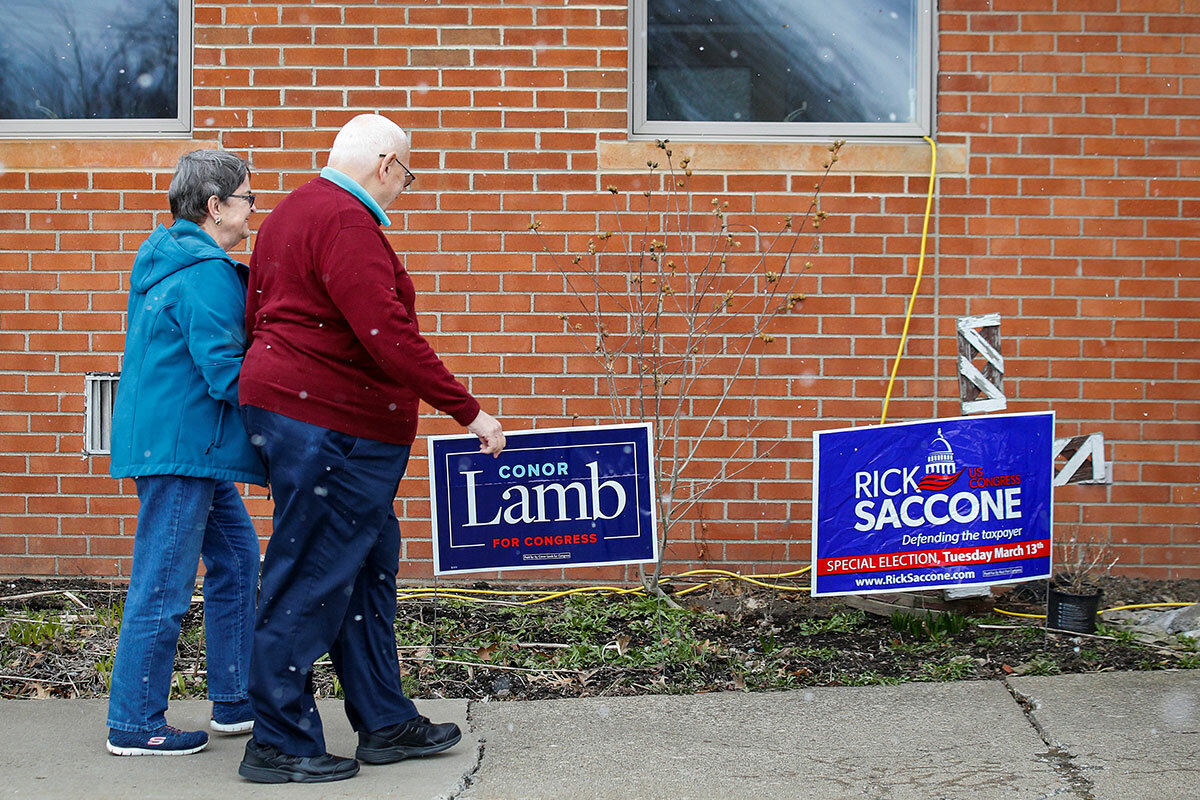In a Trump-country squeaker, some Democrats see a blueprint
| Washington
President Trump’s surprise victory in the rust belt – and thus the presidential election – 16 months ago left many Democrats despondent that they had “lost” white working-class America.
But in politics, the world never sits still. Democrat Conor Lamb’s apparent narrow win Tuesday in a special House election in western Pennsylvania, in a district that Mr. Trump had won by almost 20 points, shows that there’s a way for the party to win those voters back: Champion their issues.
Workers’ rights, wages, and protecting pensions, Social Security, and Medicare – all played to Mr. Lamb’s advantage against Republican state Rep. Rick Saccone. And, analysts say, Lamb was “conservative enough” on social issues such as guns and abortion to prevail (although, as of this writing, Mr. Saccone had not conceded and the GOP was considering a recount).
“Here’s the takeaway: Candidates matter. Campaigns matter,” says Joe DiSarro, chairman of the political science department at Washington & Jefferson College in Washington, Pa., and a member of the Republican State Committee.
“You have to be pragmatic,” Mr. DiSarro adds. “You cannot ignore 25 percent of the constituency, which is labor, and expect to win.”
In short, to boost the chances of success, a candidate should “match” the district. Unlike the Republican congressman who resigned from the 18th district House seat last October amid scandal, Saccone has taken conservative positions that labor unions oppose.
“A lot of people here are non-ideological,” said former Rep. Melissa Hart (R) of Pennsylvania, who represented a nearby district, over lunch last week in Carnegie, Pa. “This district isn’t hard right.”
Indeed, it is a district of contrasts. The wealthier, more populated, close-in Pittsburgh suburbs went strongly for Lamb, while Saccone prevailed in the further-out, more rural areas.
Long lines were reported in suburban Allegheny County – in some cases, longer than those in the 2016 general election.
“I’ve never seen so many young voters,” said Lori, a 50-something resident of Upper St. Clair who has lived in the area for more than 20 years. “Usually I’m the youngest one in line.”
‘A wake-up call’
National Republicans scrambled to regroup Wednesday, after a long night that ended with Lamb ahead by fewer than 700 votes, or two-tenths of a percent. Behind closed doors, House Speaker Paul Ryan called the Pennsylvania race a “wake-up call,” according to sources who were in the room.
Publicly, Mr. Ryan pointed to the Pennsylvania Democrats’ ability to hand-pick a “conservative” candidate, and avoid a primary dominated by activists who may have selected a more liberal nominee. During the campaign, the GOP had fought hard to turn Lamb into a “Nancy Pelosi Democrat,” referring to the House minority leader – but to no avail. Lamb disavowed Ms. Pelosi early on, saying he would not vote for her as leader.
Pennsylvania Republicans, too, selected their candidate in a state party committee vote, but wound up with someone who ended up running what was widely seen as an ineffective campaign. Saccone didn’t raise much money, forcing outside Republicans to funnel money (more than $10 million) into the race – money that now can’t be deployed in the midterms.
Democratic candidates across the country, regardless of ideology, have embraced Lamb, and are fundraising off his success. It doesn’t hurt that he’s a young, telegenic former Marine and former federal prosecutor running for office for the first time – the face of “change.”
Saccone is a generation older, and boasts an impressive career in the Air Force, diplomacy, academia, business, and now four terms in the state legislature. But to some voters, he’s part of the Harrisburg “swamp” – despite trying to wrap himself in the outsider mantle of Trump.
Six days before the election, Saccone knew he might have a problem.
“This time of year, half the people I talk to from my district are in Florida right now,” the genial Republican said in an interview at his Greensburg, Pa., field office last week. “My gosh, half of them. I’ll say, ‘Did you remember to vote absentee?’ A lot did, but a lot didn’t.”
Organized labor’s clout
Aside from Lamb, a big winner coming out of Tuesday is organized labor. In 2016, labor made the same mistake as Hillary Clinton’s presidential campaign: relying too heavily on big data, and focusing too narrowly on a small universe of undecided voters, instead of doing aggressive, widespread outreach.
This time, in the Pennsylvania race, organized labor was “focused and unified,” says Tim Waters, national political director of the Pittsburgh-based United Steelworkers, which worked alongside carpenters, painters, steamfitters, laborers, and other unions.
“In the more blue-collar towns, even if Lamb didn’t win but improved the Democratic vote significantly, it shows that unions have clout,” says Mike Mikus, a Democratic consultant who lives in Pennsylvania’s 18th district.
Then there’s the suburbs. “If the Republicans are going to stop the bleeding in wealthier, highly-educated communities, they’re going to have to create some distance from Trump,” Mr. Mikus says. “I don’t know if they’re willing.”
For now, Mikus is cautiously optimistic about a Democratic “wave” in the midterms.
"It’s a long way to the election, but all signs point to that,” he says. “If I’m a Republican running in the Philadelphia suburbs, I’m thinking of a possible graceful exit from the stage so I don’t get embarrassed in November.”
Staff writer Francine Kiefer contributed to this report.







